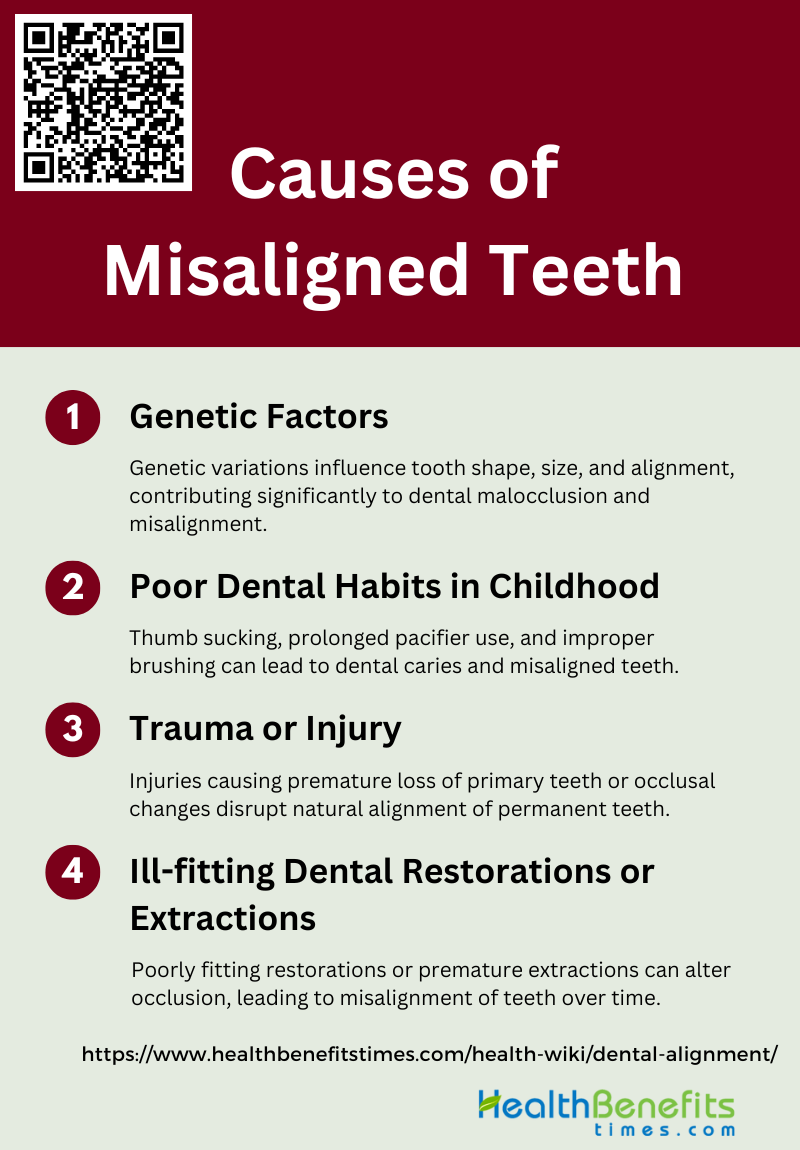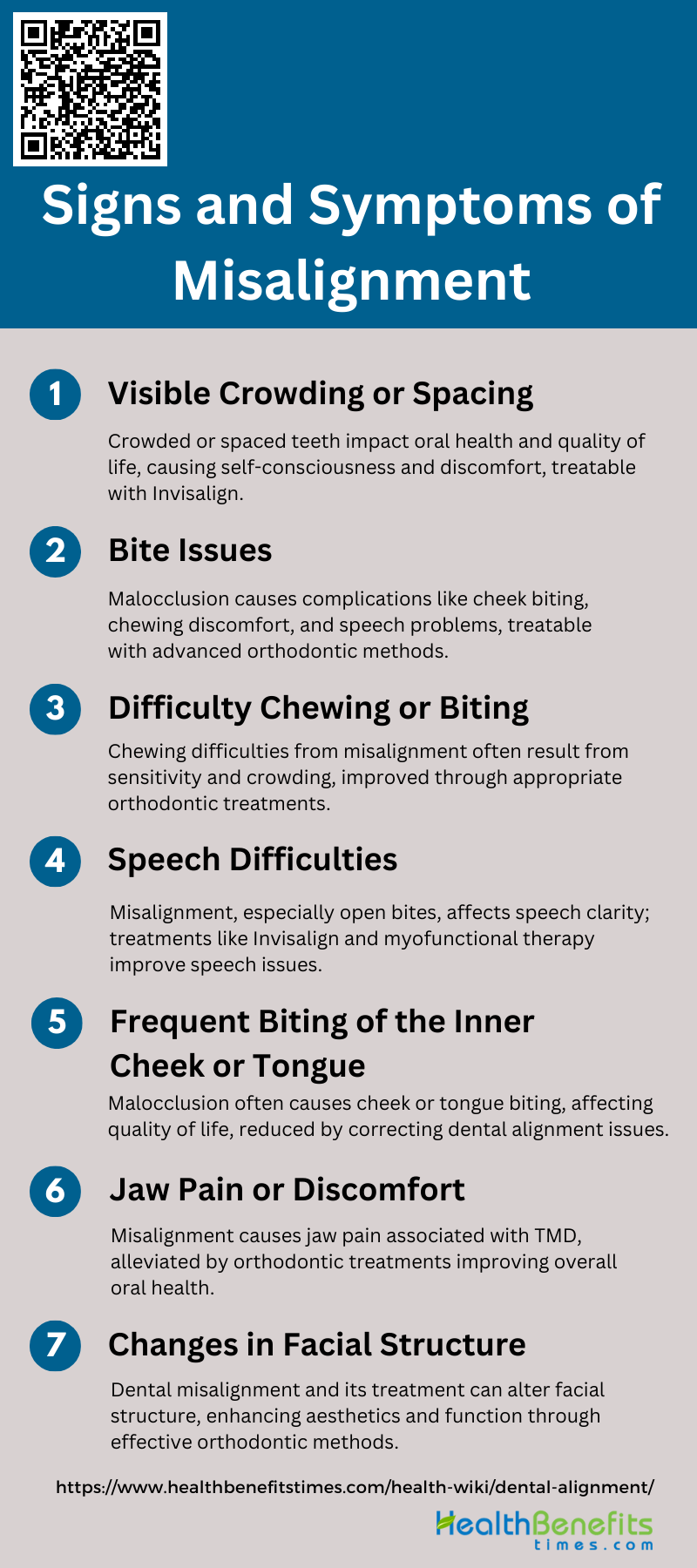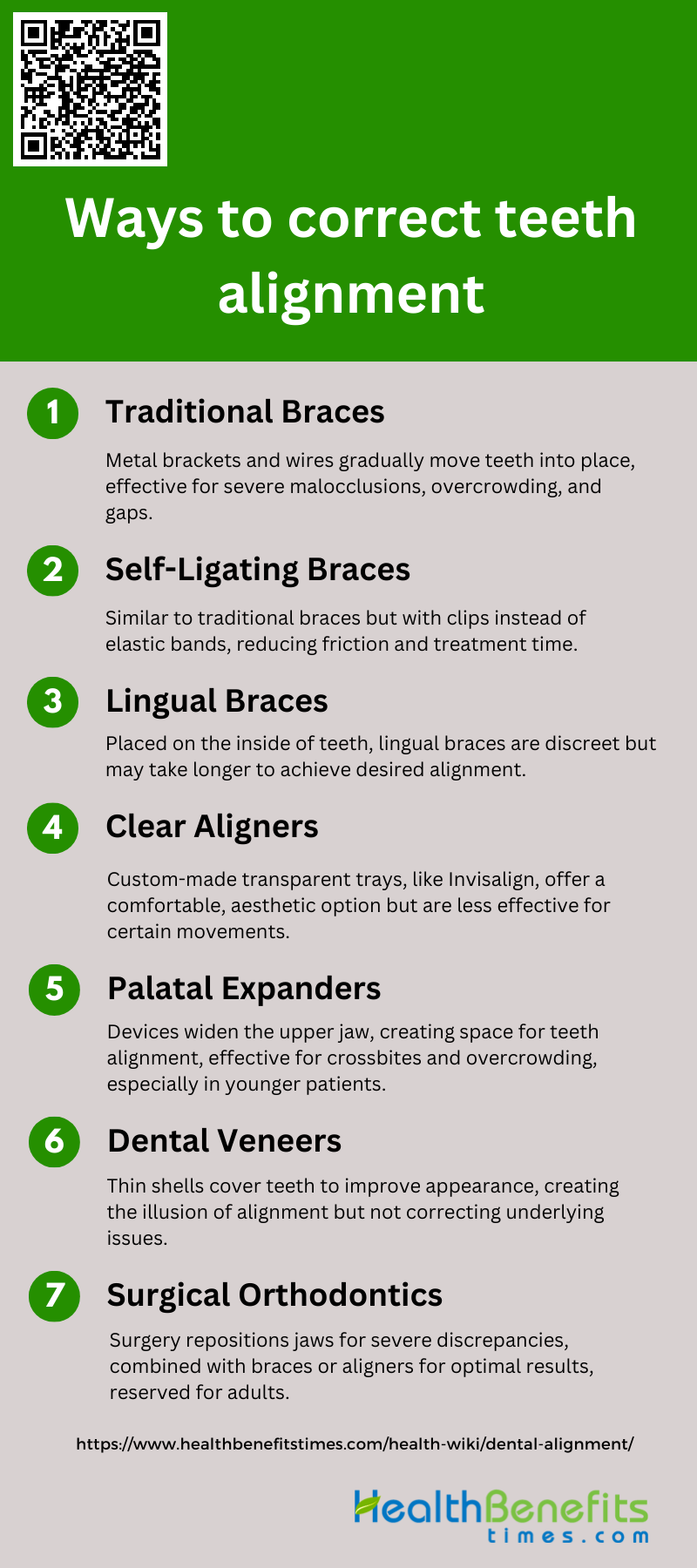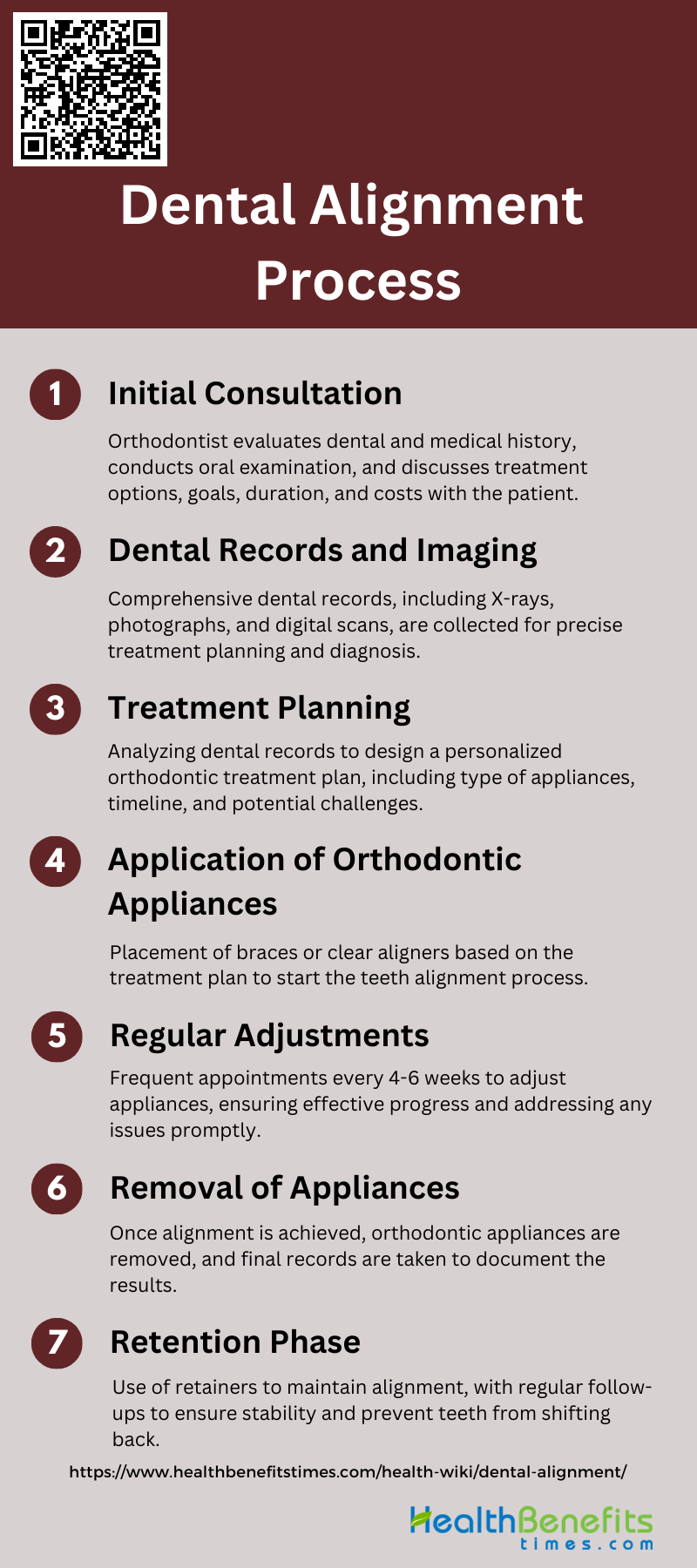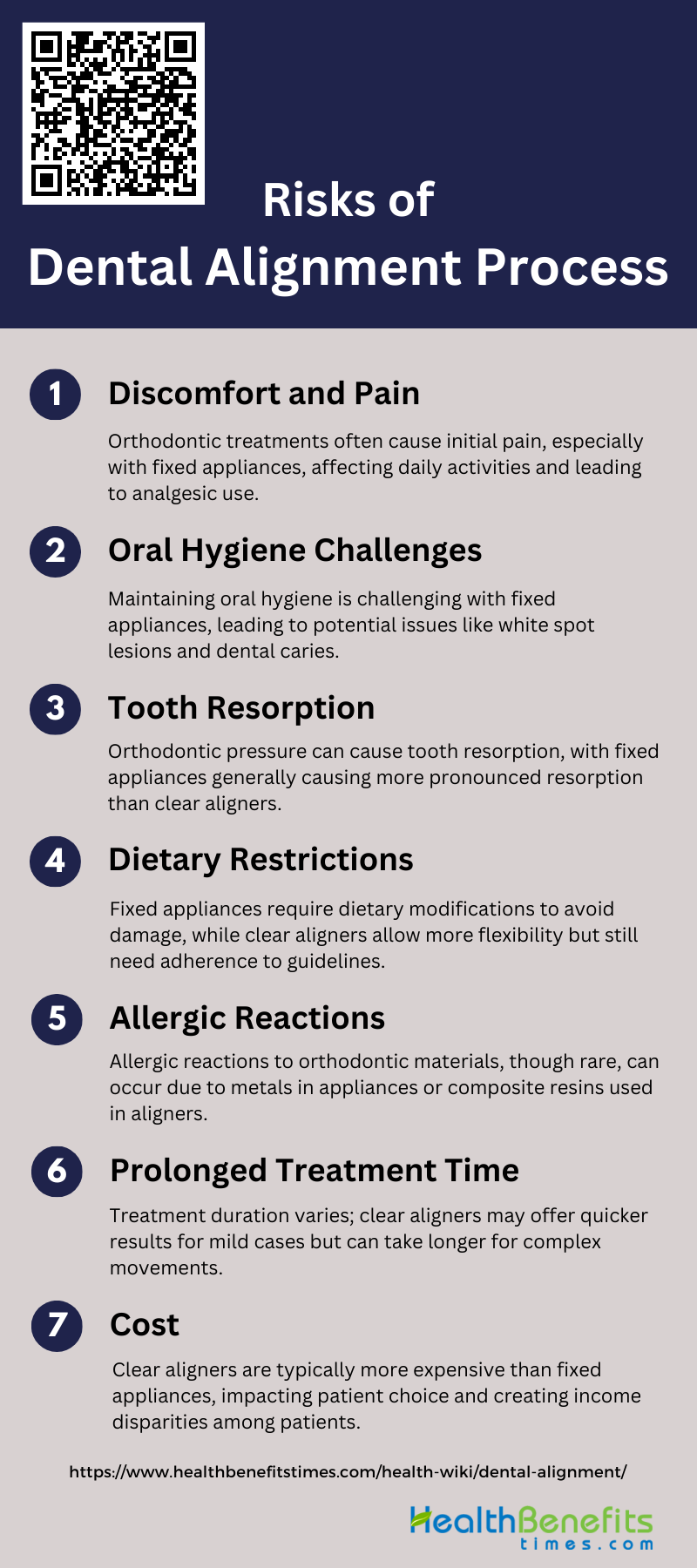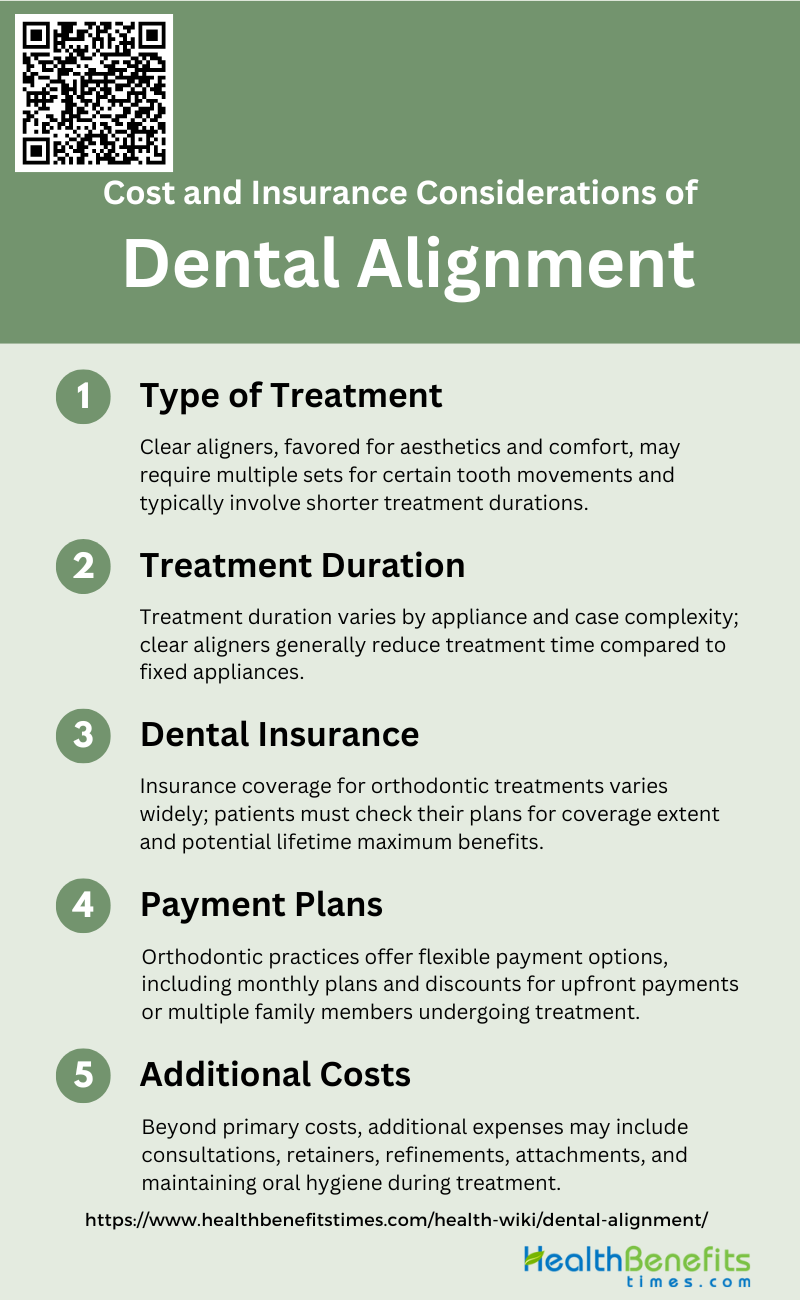 Dental alignment refers to the proper positioning and arrangement of teeth within the dental arches. It involves ensuring that the teeth are aligned correctly in relation to one another, as well as in harmony with the jaws and facial structures. Proper dental alignment is crucial for achieving optimal occlusion (bite), function, and aesthetics. Misaligned or crooked teeth can lead to various issues, such as difficulty in chewing, speech problems, increased risk of dental trauma, and an unappealing smile. Orthodontic treatment, which involves the use of braces, clear aligners, or other appliances, is often necessary to correct dental misalignments and achieve a harmonious and functional bite.
Dental alignment refers to the proper positioning and arrangement of teeth within the dental arches. It involves ensuring that the teeth are aligned correctly in relation to one another, as well as in harmony with the jaws and facial structures. Proper dental alignment is crucial for achieving optimal occlusion (bite), function, and aesthetics. Misaligned or crooked teeth can lead to various issues, such as difficulty in chewing, speech problems, increased risk of dental trauma, and an unappealing smile. Orthodontic treatment, which involves the use of braces, clear aligners, or other appliances, is often necessary to correct dental misalignments and achieve a harmonious and functional bite.
Causes of Misaligned Teeth
Misaligned teeth, a common dental issue, can arise from a variety of factors that affect the development and positioning of teeth and jaws. From genetic predispositions to environmental influences, the causes are multifaceted and can impact both oral health and aesthetics. Below is a list of the primary factors contributing to the misalignment of teeth.
1. Genetic Factors
Genetic factors play a significant role in the development of misaligned teeth. Studies have shown that genetic variations can influence the shape, size, and alignment of teeth. For instance, research on the Arara-Iriri indigenous population demonstrated that genetic cohesion due to inbreeding led to a higher prevalence of dental malocclusion in the resultant village compared to the original village. Additionally, specific genes involved in enamel formation, such as ENAM, AMELX, and TFIP11, have been associated with dental anomalies like molar-incisor hypomineralization, which can contribute to misalignment. These findings underscore the importance of genetic factors in dental development and alignment.
2. Poor Dental Habits in Childhood
Poor dental habits during childhood, such as thumb sucking, prolonged use of pacifiers, and improper brushing techniques, can lead to misaligned teeth. The Iowa Fluoride Study highlighted the impact of environmental factors, including tooth-brushing frequency, on dental health. Inadequate brushing can lead to dental caries, which in turn can affect the alignment of teeth. Moreover, untreated caries in primary molars often result in pulp inflammation and premature extraction, which significantly increases the likelihood of misalignment in the successor permanent teeth. These habits, if not corrected early, can have long-lasting effects on dental alignment.
3. Trauma or Injury
Trauma or injury to the teeth or jaw can cause misalignment. Injuries that result in the premature loss of primary teeth can disrupt the natural alignment of permanent teeth. A study on the effects of pulp inflammation and premature extraction of primary molars found that extractions performed before the age of 8 years significantly increased the odds of misalignment in the successor premolars. Additionally, trauma can lead to changes in the occlusal patterns, as observed in a 14-year clinical follow-up of implant-supported prostheses, where natural movements and mechanical factors contributed to misalignment over time. These findings highlight the impact of trauma on dental alignment.
4. Ill-fitting Dental Restorations or Extractions
Ill-fitting dental restorations or improper extractions can also lead to misaligned teeth. Dental restorations that do not fit well can alter the natural occlusion and alignment of teeth. For example, a long-term study on implant-supported prostheses revealed that misalignment between natural teeth and the prosthesis occurred over time, likely due to the lack of natural movement in the implants. Furthermore, premature extraction of primary teeth without proper space maintenance can result in misalignment of the permanent teeth, as evidenced by the increased frequency of misalignment when extractions were performed before the age of 8 years. These issues emphasize the need for precise dental procedures to maintain proper alignment.
Signs and symptoms of misalignment
Recognizing the signs and symptoms of misalignment is crucial for maintaining both mechanical and physical health. Whether it’s a misaligned spine causing discomfort or a machine part leading to operational inefficiencies, the indicators can be subtle yet impactful. Here are the key signs and symptoms to watch for:
1. Visible Crowding or Spacing
Visible crowding or spacing of teeth can significantly impact an individual’s oral health-related quality of life (OHRQoL). A study conducted on patients with anterior spacing or crowding revealed that these conditions are associated with increased self-consciousness and painful aching, particularly among those with higher educational levels and income. Additionally, the prevalence of malocclusion, including crowding, was found to be significant among children, affecting their overall dental health and quality of life. Treatment for adult crowding using Invisalign aligners has shown positive effects on interradicular bone volume, which is crucial for maintaining dental stability.
2. Bite Issues
Bite issues, such as malocclusion, can lead to various complications, including frequent biting of the inner cheeks or tongue, discomfort when chewing, and speech problems. A study on Saudi children found that a significant percentage of them had different types of malocclusion, including open bite, deep bite, and edge-to-edge bite, which can affect their overall dental health and quality of life. Treatment of anterior open bite with Invisalign has been shown to be effective, resulting in stable bite closure and improved dental alignment. Clear aligner therapy has also been successfully used to correct complex malocclusions, including open bites, demonstrating the advancements in orthodontic treatments.
3. Difficulty Chewing or Biting
Difficulty in chewing or biting is a common symptom associated with dental misalignment. A study on the acceptance and problems of Invisalign patients found that 44% of the patients experienced difficulty chewing, mainly due to teeth sensitivity or food particles getting caught between temporary gaps. This issue is particularly prevalent among individuals with severe crowding, where lower incisor proclination and protrusion are observed during treatment. Addressing these difficulties through appropriate orthodontic interventions can significantly improve the patient’s ability to chew and bite effectively.
4. Speech Difficulties
Speech difficulties can arise from dental misalignment, particularly in cases of anterior open bite and spacing. A case report demonstrated that a patient with anterior open bite and spacing experienced speech issues, including sigmatism, which was addressed through myofunctional therapy and Invisalign treatment. Another study on Invisalign patients found that 46% experienced no speech impairment, while the majority felt secure enough with their aligners to speak without inhibition. These findings highlight the importance of addressing dental misalignment to improve speech clarity and confidence.
5. Frequent Biting of the Inner Cheek or Tongue
Frequent biting of the inner cheek or tongue is a common issue associated with malocclusion. A study on Saudi children found that malocclusion can lead to frequent biting of the inner cheeks or tongue, affecting their overall quality of life. This issue is often observed in individuals with temporomandibular disorders (TMD), where joint sounds and restricted mouth opening are prevalent signs. Addressing the underlying dental misalignment through appropriate orthodontic treatments can help reduce the incidence of cheek and tongue biting.
6. Jaw Pain or Discomfort
Jaw pain or discomfort is often associated with temporomandibular disorders (TMD) and dental misalignment. A study on Saudi children found that TMD signs, such as joint sounds and restricted mouth opening, were prevalent, with muscle and temporomandibular joint (TMJ) pain being less common. Another study on Saudi adolescents reported similar findings, with joint sounds being the most prevalent sign of TMD, followed by restricted opening and opening deviation. Addressing dental misalignment through orthodontic treatments can help alleviate jaw pain and improve overall oral health.
7. Changes in Facial Structure
Changes in facial structure can result from dental misalignment and its treatment. A study on the treatment of anterior open bite with Invisalign demonstrated significant improvements in facial structure, including the closure of open bites and the achievement of functional overjet and overbite. Another study on the use of clear aligner therapy for correcting malocclusion with crowding and open bite highlighted the advancements in orthodontic treatments that allow for effective correction of complex dental issues, leading to improved facial aesthetics. These findings underscore the importance of addressing dental misalignment to achieve desirable changes in facial structure.
Ways to correct teeth alignment
Achieving a perfect smile often begins with correcting teeth alignment, which not only enhances appearance but also improves oral health. Fortunately, there are multiple methods available to straighten teeth and ensure a well-aligned bite. Here are some of the most effective ways to achieve that coveted straight smile.
1. Traditional Braces
Traditional braces are the most common and effective method for correcting teeth alignment. They consist of metal brackets that are glued to each tooth and connected by a wire, which is periodically tightened to gradually move the teeth into the desired position. Traditional braces are highly effective for treating a wide range of dental issues, including severe malocclusions, overcrowding, and gaps between teeth. The efficacy of traditional braces is well-documented, with studies showing significant improvements in both inciso-gingival and labio-lingual corrections when using various archwire and bracket combinations. Despite their visibility and potential discomfort, traditional braces remain a reliable choice for comprehensive orthodontic treatment.
2. Self-Ligating Braces
Self-ligating braces are similar to traditional braces but use a specialized clip instead of elastic bands to hold the wire in place. This design reduces friction and allows for more efficient tooth movement. Studies have shown that self-ligating braces can achieve similar or even superior results compared to traditional braces, particularly in terms of reducing treatment time and improving patient comfort. The reduced friction also means that fewer adjustments are needed, which can result in fewer visits to the orthodontist. Self-ligating braces are available in both metal and ceramic options, making them a versatile choice for patients seeking effective and efficient orthodontic treatment.
3. Lingual Braces
Lingual braces are similar to traditional braces but are placed on the inside (lingual side) of the teeth, making them virtually invisible from the outside. This makes them an attractive option for patients who are concerned about the aesthetics of traditional braces. However, studies have shown that lingual braces may be less efficient in aligning teeth compared to labial (traditional) braces, particularly in the initial stages of treatment. The vertical and anteroposterior corrections achieved with lingual braces are generally lower, which may result in longer treatment times. Despite these limitations, lingual braces offer a discreet alternative for patients who prioritize aesthetics.
4. Clear Aligners, Including Invisalign and SureSmile
Clear aligners, such as Invisalign and SureSmile, have gained immense popularity due to their aesthetic appeal and comfort. These aligners are custom-made, transparent trays that fit snugly over the teeth and are replaced every few weeks to gradually move the teeth into the desired position. Studies have shown that clear aligners are effective in controlling certain types of tooth movements, such as upper molar distalization and anterior intrusion, but may be less effective for others, such as anterior extrusion and rotation of rounded teeth. Despite these limitations, clear aligners are a popular choice for patients seeking a less noticeable and more comfortable orthodontic treatment option.
5. Palatal Expanders
Palatal expanders are devices used to widen the upper jaw, creating more space for teeth alignment. They are particularly effective in treating crossbites and overcrowding. The device is typically attached to the upper molars and gradually expanded over time to widen the palate. This method is most effective in younger patients whose jaws are still growing, but it can also be used in adults with some modifications. Palatal expanders can significantly improve the alignment of teeth by creating the necessary space for them to move into their correct positions. This method is often used in conjunction with other orthodontic treatments, such as braces or aligners, to achieve optimal results.
6. Dental Veneers
Dental veneers are thin shells of porcelain or composite resin that are custom-made to fit over the front surface of the teeth. They are primarily used for cosmetic purposes to improve the appearance of teeth that are discolored, chipped, or slightly misaligned. While veneers do not actually move the teeth, they can create the illusion of perfectly aligned teeth by covering up imperfections. This method is often referred to as “instant orthodontics” and is popular among patients seeking a quick and non-invasive solution to minor alignment issues. However, veneers do not address underlying dental problems and are not suitable for severe malocclusions or significant alignment issues.
7. Surgical Orthodontics
Surgical orthodontics, also known as orthognathic surgery, is used to correct severe jaw discrepancies and malocclusions that cannot be treated with braces or aligners alone. This procedure involves surgically repositioning the jaws to improve their alignment and function. Surgical orthodontics is typically combined with traditional braces or clear aligners to achieve optimal results. This method is often reserved for adult patients whose jaws have stopped growing and who have significant skeletal discrepancies. While surgical orthodontics can be highly effective in achieving dramatic improvements in both function and aesthetics, it is a more invasive option and requires a longer recovery period compared to other orthodontic treatments.
Dental Alignment Process
The dental alignment process involves a series of steps designed to straighten and align teeth for improved oral health and aesthetics. This process typically includes initial consultations, treatment planning, and the use of orthodontic appliances. Below are the key stages involved in the dental alignment process:
1. Initial Consultation
The initial consultation is a critical step in the dental alignment process, where the orthodontist evaluates the patient’s dental and medical history, conducts a thorough oral examination, and discusses the patient’s concerns and treatment goals. This stage often involves a preliminary assessment of the teeth and jaw alignment, and the orthodontist may take initial photographs and impressions of the teeth. The consultation provides an opportunity to explain the various treatment options, including the use of clear aligners or traditional braces, and to discuss the expected duration and cost of the treatment. Establishing a clear understanding and setting realistic expectations are essential for a successful orthodontic journey.
2. Dental Records and Imaging
During this phase, comprehensive dental records are collected to create a detailed map of the patient’s oral structure. This includes taking X-rays, photographs, and digital scans of the teeth and jaws. Advanced imaging techniques, such as 3D dental scans, are often employed to ensure precise measurements and to aid in the accurate planning of the treatment. These records are crucial for diagnosing any underlying issues and for developing a customized treatment plan. The use of technologies like MRI can provide detailed sectional information, which is particularly useful for complex cases involving dental implants or orthognathic surgery.
3. Treatment Planning
The treatment planning stage involves analyzing the collected dental records and imaging to design a personalized orthodontic treatment plan. This plan outlines the specific steps and appliances needed to achieve the desired dental alignment. Digital tools and software are often used to simulate the treatment process and predict the outcomes, allowing for precise adjustments and modifications before the actual treatment begins. The orthodontist will discuss the proposed plan with the patient, including the type of braces or aligners to be used, the estimated timeline, and any potential challenges or considerations.
4. Application of Orthodontic Appliances
Once the treatment plan is finalized, the orthodontic appliances are applied. This could involve the placement of traditional braces, which include brackets, wires, and bands, or the fitting of clear aligners. The choice of appliance depends on the specific needs and preferences of the patient. For instance, clear aligners are effective for controlling certain types of tooth movements but may have limitations in others, such as anterior extrusion. The initial arch wires used in braces play a crucial role in the early stages of tooth alignment, and their selection can impact the speed and comfort of the treatment.
5. Regular Adjustments
Regular adjustments are necessary to ensure the orthodontic appliances are working effectively and to make any needed modifications to the treatment plan. These appointments typically occur every 4-6 weeks and involve tightening the wires, changing the aligners, or making other adjustments to guide the teeth into their correct positions. The frequency and nature of these adjustments can vary based on the type of appliance used and the individual progress of the patient. Monitoring and adjusting the treatment plan helps in addressing any issues promptly and maintaining the momentum of the alignment process.
6. Removal of Appliances
Once the desired alignment is achieved, the orthodontic appliances are removed. This stage marks the end of the active treatment phase and involves taking final records, including photographs and impressions, to document the results. The removal process is typically straightforward, but it requires careful handling to avoid damaging the teeth or gums. The orthodontist will also evaluate the overall outcome and ensure that the teeth and jaws are in the correct positions. This final assessment is crucial for planning the next phase of treatment, which focuses on maintaining the achieved alignment.
7. Retention Phase
The retention phase is critical for maintaining the results achieved during the active treatment. Retainers, which can be either removable or fixed, are used to hold the teeth in their new positions and prevent them from shifting back. The type and duration of retainer use depend on the individual case and the orthodontist’s recommendations. Regular follow-up appointments are necessary to monitor the stability of the alignment and to make any necessary adjustments to the retainers. This phase ensures the long-term success of the orthodontic treatment and helps in preserving the patient’s new smile.
Risks of Dental Alignment Process
The dental alignment process, while beneficial for correcting teeth positioning and improving oral health, carries several risks that patients should be aware of. These risks can range from mild discomfort to more severe complications. Below are some of the potential risks associated with dental alignment procedures:
1. Discomfort and Pain
Orthodontic treatments, whether using clear aligners or traditional fixed appliances, often result in discomfort and pain, particularly during the initial stages. Studies have shown that pain levels peak on the first day and gradually decrease over time. Patients using fixed appliances report significantly higher pain levels compared to those using clear aligners during the first week of treatment. This discomfort can affect daily activities such as chewing and sleeping, leading to increased consumption of analgesics among patients with fixed appliances.
2. Oral Hygiene Challenges
Maintaining oral hygiene during orthodontic treatment can be challenging, especially with fixed appliances. Clear aligners, however, have been associated with better oral hygiene outcomes. Studies indicate that patients using clear aligners have lower plaque scores and fewer instances of S. mutans and lactobacilli compared to those with fixed appliances. Despite this, inadequate oral hygiene can still lead to significant issues such as white spot lesions and dental caries, particularly if aligners are worn for extended periods without proper cleaning.
3. Tooth Resorption
Tooth resorption is a potential risk during orthodontic treatment, where the tooth structure is broken down and absorbed into the surrounding bone. This can occur due to the pressure exerted by orthodontic appliances. While both clear aligners and fixed appliances can cause tooth resorption, the extent and severity can vary. The continuous pressure from fixed appliances may lead to more pronounced resorption compared to the intermittent pressure from clear aligners.
4. Dietary Restrictions
Orthodontic treatments often necessitate dietary modifications to prevent damage to the appliances and ensure effective treatment. Patients with fixed appliances are typically advised to avoid hard, sticky, and chewy foods that can dislodge brackets or wires. Clear aligners offer more flexibility as they can be removed during meals, allowing patients to maintain a more regular diet. However, patients must still adhere to guidelines to avoid staining and ensure proper oral hygiene.
5. Allergic Reactions
Allergic reactions to orthodontic materials, though rare, can occur. These reactions are often due to the metals in fixed appliances or the composite resins used in clear aligners. The acid-etch technique used to bond composite attachments to teeth can introduce bisphenol A (BPA), an endocrine-disrupting agent, into the oral environment, potentially causing allergic reactions or other health issues. It is crucial for patients to inform their orthodontists of any known allergies to avoid adverse reactions.
6. Prolonged Treatment Time
The duration of orthodontic treatment can vary significantly based on the complexity of the case and the type of appliance used. Clear aligners are often perceived to offer a quicker treatment time for mild to moderate cases, but complex cases may still require longer durations similar to fixed appliances. Studies have shown that while clear aligners can effectively align and level arches, they may not be as efficient in controlling certain tooth movements, potentially prolonging treatment time.
7. Cost
The cost of orthodontic treatment can be a significant concern for many patients. Clear aligners tend to be more expensive than traditional fixed appliances due to the advanced technology and materials used. This cost difference can impact a patient’s choice of treatment. Studies have highlighted that the higher cost of clear aligners can lead to income disparities among patients, with those opting for aligners generally having higher incomes. Despite the higher cost, many patients prefer clear aligners for their aesthetic and comfort benefits.
Cost and Insurance Considerations of Dental Alignment
When considering dental alignment, it’s important to understand the various costs involved and how insurance coverage can impact your financial planning. From initial consultations to ongoing adjustments, expenses can add up quickly. Here are some key factors to keep in mind:
1. Type of Treatment
Dental alignment treatments primarily include clear aligner therapy (CAT) and fixed appliance therapy (FAT). Clear aligners, such as Invisalign, are preferred for their aesthetic appeal and comfort, although they may not be as effective as traditional braces in certain movements like controlling teeth torque and producing adequate occlusal contacts. Clear aligners are particularly effective in mild to moderate malocclusions and offer advantages in terms of shorter treatment duration and reduced chair time. However, they may require multiple sets of trays to achieve the desired outcome.
2. Treatment Duration
The duration of dental alignment treatment varies depending on the type of appliance used and the complexity of the case. Clear aligners generally result in a shorter treatment duration compared to fixed appliances. Studies have shown that clear aligners can reduce treatment time by approximately 6.31 months compared to traditional braces. Additionally, the use of Dental Monitoring (DM) with clear aligners can further reduce the number of appointments and the time to the first refinement, enhancing the overall efficiency of the treatment.
3. Dental Insurance
Dental insurance coverage for orthodontic treatments, including clear aligners and fixed appliances, varies widely. Some insurance plans may cover a portion of the treatment cost, while others may not cover orthodontic treatments at all. It is essential for patients to check with their insurance providers to understand the extent of coverage. The cost-effectiveness of clear aligners compared to traditional braces can be a significant factor for patients when considering their options. Insurance plans that do cover orthodontic treatments often have a lifetime maximum benefit, which may not fully cover the total cost of the treatment.
4. Payment Plans
Many orthodontic practices offer flexible payment plans to make dental alignment treatments more affordable. These plans may include monthly payment options, interest-free financing, and extended payment terms. Payment plans can help patients manage the high upfront costs associated with treatments like clear aligners, which can be more expensive than traditional braces. Practices may also offer discounts for full payment upfront or for multiple family members undergoing treatment simultaneously.
5. Additional Costs
In addition to the primary cost of the aligners or braces, patients should be aware of potential additional costs. These can include the cost of initial consultations, diagnostic records, retainers, and any necessary refinements or adjustments during the treatment. Clear aligners may also require the use of attachments or composite resin bonding, which can add to the overall cost and may involve additional procedures such as enamel etching and grinding. Patients should also consider the cost of maintaining oral hygiene and any potential periodontal treatments that may be needed during the course of orthodontic treatment.


